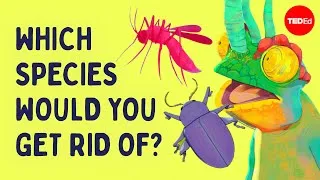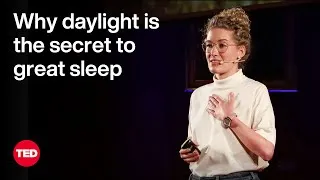The smallest solution to one of our biggest problems - Tierney Thys & Christian Sardet
501,833 views ・ 2022-07-07
請雙擊下方英文字幕播放視頻。
譯者: Camila Lin
審譯者: Helen Chang
00:11
At this very moment, almost everything
around you is being eaten.
0
11090
4588
此刻,你周遭的一切幾乎都在被啃食。
00:15
Invisible to the naked eye, organisms
called microbes swarm every surface.
1
15762
5839
肉眼看不見的微生物
遍佈所有物體表面。
00:21
Hordes of bacteria, archaea, and fungi
have evolved to produce powerful enzymes
2
21893
6131
大量的細菌、古菌和真菌,
已經進化到能產出強大的酵素,
00:28
that break down tough organic material
into digestible nutrients.
3
28024
4755
可分解結實的有機物,
將其轉化為可被消化的營養。
00:33
But there’s one particularly widespread
type of material
4
33196
3545
但幾乎沒有微生物可生物分解
某種隨處可見的物質:
00:36
that almost no microbes can biodegrade:
5
36741
3086
00:39
plastics.
6
39827
1418
塑膠。
00:41
To make most plastics, molecules
from oil, gas and coal are refined
7
41245
5548
為了製造大部分的塑膠,
我們提煉石油、天然氣和煤炭的分子,
將其重新排列,製成
又長又重複的連結,稱為聚合物。
00:46
and turned into long, repeating chains
called polymers.
8
46793
4546
00:51
This process often requires temperatures
above 100˚C, incredibly high pressure,
9
51714
6590
這個過程通常需要攝氏
100 度以上的溫度、驚人的高壓,
00:58
and various chemical modifications.
10
58304
2920
以及各種化學改質。
01:01
The resulting man-made polymers
are quite different
11
61682
3212
這種人工製造的聚合物,
和天然聚合物相當不同。
01:04
from the polymers found in nature.
12
64894
2002
01:06
And since they’ve only been
around since the 1950s,
13
66896
3545
因為它們在 1950 年代才出現,
01:10
most microbes haven’t had time to evolve
enzymes to digest them.
14
70441
5297
大多數的微生物還沒有足夠的時間,
進化出可分解塑膠的酵素。
01:16
Making matters even more difficult,
15
76114
2127
讓事態更難以收拾的是,
01:18
breaking most plastics’ chemical bonds
requires high temperatures
16
78241
4546
想分解塑膠的化學鍵,
需要和製造塑膠時差不多的高溫,
01:22
comparable to those used to create them—
17
82787
2502
01:25
and such heat is deadly to most microbes.
18
85289
3087
而絕大多數的微生物,
都無法在這種溫度下生存。
01:28
This means that most plastics
never biologically degrade—
19
88835
4254
意味著大多數的塑膠
都不可能被生物分解,
01:33
they just turn into countless, tiny,
indigestible pieces.
20
93089
4212
只能成為無數細小、不可分解的碎片。
01:37
And pieces from the most common plastics
like Polyethylene, Polypropylene,
21
97593
5214
而最常見的塑膠製品,
如聚乙烯、聚丙烯,
01:42
and Polyester-terephthalate
have been piling up for decades.
22
102807
4629
和聚酯-對苯二甲酸酯的碎片,
已經堆積了數十年。
01:48
Each year humanity produces roughly
400 million more tons of plastic,
23
108813
5797
我們每年約會製造四億多噸的塑膠,
01:54
80% of which is discarded as trash.
24
114610
3295
其中有 80% 都被當成垃圾丟棄。
01:58
Of that plastic waste,
only 10% is recycled.
25
118197
4171
只有一成的塑膠垃圾會被回收。
02:02
60% gets incinerated
or goes into the landfills,
26
122577
3920
六成的垃圾會被焚燒或掩埋,
02:06
and 30% leaks out into the environment
27
126497
3212
三成則會流入環境,
02:09
where it will pollute natural ecosystems
for centuries.
28
129709
3795
汙染自然生態系統長達數百年。
02:13
An estimated 10 million tons of plastic
waste end up in the ocean each year,
29
133671
6089
據估計,每年約有一千萬噸的
塑膠垃圾流入海洋,
02:19
mostly in the form of microplastic
fragments that pollute the food chain.
30
139760
4964
大多數都成了汙染食物鏈的塑膠微粒。
02:25
Fortunately, there are microbes
that may be able
31
145224
3253
幸運的是,我們現在已發現
也許能將日益嚴重的
塑膠危機分解的微生物。
02:28
to take a bite out of this
growing problem.
32
148477
2753
02:31
In 2016, a team of Japanese researchers
sampling sludge
33
151439
4880
2016 年,一支日本研究團隊,
至寶特瓶回收工廠取樣汙泥時,
02:36
at a plastic-bottle recycling plant
discovered
34
156319
3003
發現了大阪堺菌 201-F6。
02:39
Ideonella sakaiensis 201-F6.
35
159322
4379
02:43
This never-before-identified bacterium
contained two enzymes
36
163951
4838
這個首次被發現的細菌含有兩種酵素,
02:48
capable of slowly breaking
down PET polymers
37
168789
4380
可在相對低溫的環境中,
緩慢分解 PET 塑膠聚合物。
02:53
at relatively low temperatures.
38
173169
2169
02:55
Researchers isolated the genes coding
for these plastic-digesting enzymes,
39
175504
5047
研究者將製造這種
酵素的基因編碼分離,
03:00
allowing other bioengineers to combine
and improve the pair—
40
180551
4713
讓其他生物工程師結合、
增強這兩種酵素,
03:05
creating super-enzymes that could break
down PET up to 6 times faster.
41
185264
5839
創造出能以六倍速
分解塑膠的超級酵素。
03:11
Even with this boost,
42
191687
1627
雖然已經過改良,
03:13
these lab-grown enzymes still took weeks
to degrade a thin film of PET,
43
193314
5923
這些實驗室培養的超級酵素
仍需花費數週才能分解一片 PET 薄膜,
03:19
and they operated best at temperatures
below 40˚C.
44
199237
4212
且在低於攝氏 40 度時表現最佳。
03:23
However, another group of scientists
in Japan had been researching
45
203950
3837
然而,另一個日本科學家團隊,
長期研究細菌酵素
對高溫環境的適應力,
03:27
bacterial enzymes adapted
to high temperature environments
46
207787
4087
03:31
like compost piles.
47
211874
1752
例如堆肥。
03:34
And within one particularly warm pile
of rotting leaves and branches,
48
214001
4922
而在特別溫熱的一堆腐葉和樹枝中,
03:38
they found gene sequences
for powerful degrading enzymes
49
218923
4254
他們發現了一組能製造
強大分解酵素的基因序列,
03:43
known as Leaf Branch Compost Cutinases.
50
223177
3420
也就是「葉枝堆肥角質酶」。
03:47
Using fast-growing microorganisms,
51
227098
2586
利用快速生長的微生物,
03:49
other researchers were able
to genetically engineer
52
229684
3128
其他研究者也能利用基因工程,
03:52
high quantities of these enzymes.
53
232812
2294
培養出大量這種酵素。
03:55
They then enhanced and selected
special variants of the Cutinases
54
235106
3879
接著,他們增強、選擇
一種特定的角質酶變體,
03:58
that could degrade PET plastic
in environments reaching 70˚C—
55
238985
5297
它能在攝氏 70 度下
分解 PET 塑膠,
04:04
a high temperature that can weaken
PET polymers and make them digestible.
56
244282
4796
這種溫度可軟化 PET 塑膠,
讓它們更易分解。
04:09
With the help of these
and other tiny diehards,
57
249245
3462
有了這些細菌的幫助,
04:12
the future of PET recycling
looks promising.
58
252707
3461
回收 PET 塑膠看似前景可期。
04:16
But PET is just one type of plastic.
59
256252
3295
但 PET 只是一種塑膠。
04:19
We still need ways to biologically degrade
all the other types,
60
259922
4463
我們仍需要找到能夠生物分解
其他的塑膠的方法,
04:24
including abundant PEs and PPs
61
264385
3295
其中包含大量的聚苯醚碸和聚苯硫醚,
04:27
which only begin breaking down
at temperatures well above 130˚C.
62
267680
6173
它們要在攝氏 130 度
以上才能被分解。
04:33
Researchers don’t currently know
of any microbes or enzymes
63
273978
4421
研究者現在仍未發現任何
04:38
tough enough to tolerate
such temperatures.
64
278399
2836
能忍受這種高溫的微生物或酵素。
04:41
So for now, the main way we deal
with these plastics
65
281902
3129
所以,我們現在處理
這些塑膠的主要方法,
04:45
is through energy-intensive physical
and chemical processes.
66
285031
4170
是高能量的物理和化學過程。
04:49
Today only a small fraction
of plasticwaste
67
289493
2837
今天,只有一小部分的塑膠垃圾,
04:52
can be biologically degraded by microbes.
68
292330
2961
可被微生物生物分解。
04:55
Researchers are looking for more
heat-tolerant plastivores
69
295374
3504
研究者還在地球最惡劣的環境中,
04:58
in the planet’s most hostile environments
70
298878
2377
尋找更多能耐高熱、
可分解塑膠的微生物,
05:01
and engineering better
plastivorous enzymes in the lab.
71
301255
3837
並在實驗室中,以基因改造做出
更優秀的塑膠分解酵素。
05:05
But we can’t rely solely on these tiny
helpers to clean up our enormous mess.
72
305593
5839
但我們不能只靠這些小幫手
清理我們製造出的巨量垃圾。
05:12
We need to completely rethink
our relationship with plastics,
73
312350
3712
我們必須從頭反省我們和塑膠的關係,
05:16
make better use of existing plastics,
74
316520
2878
更完善地利用已存的塑膠產品,
05:19
and stopproducing more of the same.
75
319982
2795
並不再製造更多塑膠產品。
05:23
And we urgently need to design more
environmentally friendly types of polymers
76
323486
5297
我們也需要快點設計出
對環境更友善的聚合物,
05:29
that our growing entourage of plastivores
can easily break down.
77
329408
4630
讓不停增長的塑膠分解微生物,
可輕易將它們分解。
New videos
Original video on YouTube.com
關於本網站
本網站將向您介紹對學習英語有用的 YouTube 視頻。 您將看到來自世界各地的一流教師教授的英語課程。 雙擊每個視頻頁面上顯示的英文字幕,從那裡播放視頻。 字幕與視頻播放同步滾動。 如果您有任何意見或要求,請使用此聯繫表與我們聯繫。







